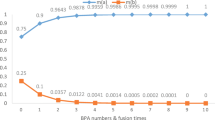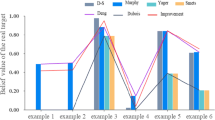Abstract
To address highly conflicting evidence combinations, a new base function is proposed to alleviate conflicts that exist in pieces of evidence provided before the fusion of them to get intuitive results from the combination. The proposed method assigns a corresponding value to each proposition according to its importance. Single subset propositions are considered more crucial than multiple ones, which intends to reduce uncertainties existing in the frame of discernment so that indicative results of combination can be obtained. More than that, to avoid a considerable deviation from the modified mass to the original ones, an operation of average is carried out twice to achieve this effect. The proposed conflicting management method not only has the advantage of eliminating conflicts among evidence but also the ability to produce intuitive results. Several numerical examples and experiments using datasets are illustrated to verify the accuracy and correctness of the proposed method in processing highly conflicting information.
Similar content being viewed by others
References
Yager RR (2019) Generalized Dempster–Shafer structures. IEEE Trans Fuzzy Syst 27(3):428–435
Dempster AP (1967) Upper and lower probabilities induced by a Multi-Valued mapping. Ann Math Stat 38(2):325–339
Shafer G (1976) A Mathematical Theory of Evidence. Princeton University Press, Princeton. https://doi.org/10.1515/9780691211696
Zhang J, Liu R, Zhang J, Kang B (2020) Extension of Yager’s negation of a probability distribution based on Tsallis entropy. Int J Intell Syst 35(1):72–84
Lai JW, Cheong KH (2020) Parrondo’s paradox from classical to quantum: a review. Nonlinear Dyn:1–13
Fujita H, Ko Y-C (2020) A heuristic representation learning based on evidential memberships: Case study of UCI-SPECTF. Int J Approx Reason 120
Jiang W, Huang C, Deng X (2019) A new probability transformation method based on a correlation coefficient of belief functions. Int J Intell Syst 34:1337–1347
Jiang W (2018) A correlation coefficient for belief functions. Int J Approx Reason 103:94–106
Liu Z, Zhang X, Niu J, Dezert J (2020) Combination of classifiers with different frames of discernment based on belief functions. IEEE Transactions on Fuzzy Systems. https://doi.org/10.1109/TFUZZ.2020.2985332
Deng X, Jiang W (2020) On the negation of a Dempster–Shafer belief structure based on maximum uncertainty allocation. Inf Sci 516:346–352
Zhou M, Liu X-B, Chen Y-W, Qian X-F, Yang J-B, Wu J (2020) Assignment of attribute weights with belief distributions for MADM under uncertainties. Knowl-Based Syst 189:105110
Xu X, Li S, Song X, Wen C, Xu D (2016) The optimal design of industrial alarm systems based on evidence theory. Control Eng Pract 46:142–156
Cheong KH, Koh JM (2019) A hybrid genetic-levenberg marquardt algorithm for automated spectrometer design optimization. Ultramicroscopy 202:100–106
Tian Y, Liu L, Mi X, Kang B (2020) ZSLF: A new soft likelihood function based on Z-numbers and its application in expert decision system. IEEE Transactions on Fuzzy Systems. https://doi.org/10.1109/TFUZZ.2020.2997328
Fei L, Feng Y, Liu L, Mao W (2019) On intuitionistic fuzzy decision-making using soft likelihood functions. Int J Intell Syst 34(9):2225–2242
Liu P, Zhang X (2020) A new hesitant fuzzy linguistic approach for multiple attribute decision making based on Dempster–Shafer evidence theory. Appl Soft Comput 86:105897
Garg H, Rani D (2019) Some results on information measures for complex intuitionistic fuzzy sets. Int J Intell Syst 34(10):2319–2363
Zadeh LA (2011) A note on Z-numbers. Inf Sci 181(14):2923–2932
Liu Q, Tian Y, Kang B (2019) Derive knowledge of Z-number from the perspective of Dempster–Shafer evidence theory. Eng Appl Artif Intell 85:754–764
Jiang W, Cao Y, Deng X (2019) A novel Z-network model based on Bayesian network and Z-number. IEEE Transactions on Fuzzy Systems. https://doi.org/10.1109/TFUZZ.2019.2918999
Tian Y, Liu L, Mi X, Kang B (2020) ZSLF: A new soft likelihood function based on Z-numbers and its application in expert decision system. IEEE Transactions on Fuzzy Systems. https://doi.org/10.1109/TFUZZ.2020.2997328
Liu Q, Tian Y, Kang B (2019) Derive knowledge of Z-number from the perspective of Dempster–Shafer evidence theory. Eng Appl Artif Intell 85:754–764
Deng X, Jiang W (2019) A total uncertainty measure for D numbers based on belief intervals. Int J Intell Syst 34(12):3302–3316
Liu P, Zhang X, Wang Z (2020) An extended VIKOR method for multiple attribute decision making with linguistic D numbers based on fuzzy entropy. Int J Inf Technol Decis Mak 19(1):143–167
Song Y, Fu Q, Wang Y-F, Wang X (2019) Divergence-based cross entropy and uncertainty measures of Atanassov’s intuitionistic fuzzy sets with their application in decision making. Appl Soft Comput 84:105703
Feng F, Cho J, Pedrycz W, Fujita H, Herawan T (2016) Soft set based association rule mining. Knowl-Based Syst 111:268–282
Xiao F (2020) CEQD: A complex mass function to predict interference effects. IEEE Transactions on Cybernetics. https://doi.org/10.1109/TCYB.2020.3040770
Xiao F (2021) CED: A distance for complex mass functions. IEEE Trans Neural Netw Learn Syst 32(4):1525–1535
Xiao F (2020) Generalized belief function in complex evidence theory. J Intell Fuzzy Syst 38 (4):3665–3673
Garg H, Rani D (2019) Novel aggregation operators and ranking method for complex intuitionistic fuzzy sets and their applications to decision-making process, Neural Computing and Applications, pp. DOI: 10.1007/s10 462–019–09 772–x
Gao X, Deng Y (2020) Quantum Model of Mass Function. Int J Intell Syst 35(2):267–282
Xiao F (2019) Generalization of Dempster–Shafer theory: A complex mass function. Appl Intell 50(10):3266–3275
Yang J, Huang H-Z, He L-P, Zhu S-P, Wen D (2011) Risk evaluation in failure mode and effects analysis of aircraft turbine rotor blades using Dempster–Shafer evidence theory under uncertainty. Eng Fail Anal 18(8):2084–2092
Pan Y, Zhang L, Wu X, Skibniewski MJ (2020) Multi-classifier information fusion in risk analysis. Inf Fusion 60:121–136
Pan Y, Zhang L, Li Z, Ding L (2019) Improved fuzzy bayesian network-based risk analysis with interval-valued fuzzy sets and d-s evidence theory. IEEE Trans Fuzzy Syst:1–1
Dong G, Kuang G (2015) Target recognition via information aggregation through Dempster–Shafer’s evidence theory. IEEE Geosci Remote Sens Lett 12(6):1247–1251
Liu F, Deng Y (2021) Determine the number of unknown targets in Open World based on Elbow method. IEEE Transactions on Fuzzy Systems 29(5):986–995
Pan L, Deng Y (2020) An association coefficient of belief function and its application in target recognition system. Int J Intell Syst 35:85–104
Liu Z, Liu Y, Dezert J, Cuzzolin F (2020) Evidence combination based on credal belief redistribution for pattern classification. IEEE Trans Fuzzy Syst 28(4):618–631
Fu C, Xu DL, Yang S (2016) Distributed preference relations for multiple attribute decision analysis. J Oper Res Soc 67(3):457–473
Liao H, Ren Z, Fang R (2020) A Deng-entropy-based evidential reasoning approach for multi-expert multi-criterion decision-making with uncertainty. Int J Comput Intell Syst 13(1):1281–1294
Zhou M, Liu X-B, Chen Y-W, Yang J-B (2018) Evidential reasoning rule for MADM with both weights and reliabilities in group decision making. Knowl-Based Syst 143:142–161
Cao Z, Chuang C-H, King J-K, Lin C-T (2019) Multi-channel EEG recordings during a sustained-attention driving task. Sci Data 6:https://doi.org/10.1038/s41597--019--0027--4
Xiao F (2020) EFMCDM: Evidential Fuzzy multicriteria decision making based on belief entropy. IEEE Trans Fuzzy Syst 28(7):1477–1491
Wang X, Song Y (2018) Uncertainty measure in evidence theory with its applications. Appl Intell 48(7):1672–1688
Deng Y (2021) Uncertainty measure in evidence theory. Sci CHINA Inf Sci 64
Xiao F (2021) A distance measure for intuitionistic fuzzy sets and its application to pattern classification problems. IEEE Transactions on Systems, Man, and Cybernetics, Systems 51(6):3980–3992
Deng Y (2020) Information volume of mass function. Int J Comput Commun Control 15(6):3983
Fei L, Feng Y, Liu L (2019) Evidence combination using OWA-based soft likelihood functions. Int J Intell Syst 34(9):2269– 2290
Deng J, Deng Y (2021) Information volume of fuzzy membership function. Int J Comput Commun Control 16(1):4106
Song Y, Zhu J, Lei L, Wang X (2020) A self-adaptive combination method for temporal evidence based on negotiation strategy. SCIENCE CHINA Information Sciences. https://doi.org/10.1007/s11,432--020--3045--5
Pan L, Deng Y (2020) Probability transform based on the ordered weighted averaging and entropy difference. Int J Comput Commun Control 15(4):3743
Ma J, Ma Y, Li C (2019) Infrared and visible image fusion methods and applications: a survey. Inf Fusion 45:153–178
Luo Z, Deng Y (2020) A vector and geometry interpretation of basic probability assignment in Dempster-Shafer theory. Int J Intell Syst 35(6):944–962
Lefevre E, Colot O, Vannoorenberghe P (2002) Belief function combination and conflict management. Inf Fusion 3(2):149–162
Yager RR (1987) On the dempster-shafer framework and new combination rules. Inf Sci 41 (2):93–137
Murphy CK (2000) Combining belief functions when evidence conflicts. Decis Support Syst 29 (1):1–9
Deng Y, Shi W, Zhu Z, Liu Q (2004) Combining belief functions based on distance of evidence. Decis Support Syst 38(3):489– 493
Zhou M, Liu X, Yang J (2017) Evidential reasoning approach for MADM based on incomplete interval value. J Intell Fuzzy Syst 33(6):3707–3721
Xu X, Xu H, Wen C, Li J, Hou P, Zhang J (2018) A belief rule-based evidence updating method for industrial alarm system design. Control Eng Pract 81:73–84
Liu Z-G, Pan Q, Dezert J, Martin A (2018) Combination of classifiers with optimal weight based on evidential reasoning. IEEE Trans Fuzzy Syst 26(3):1217–1230
Xiao F (2020) Evidence combination based on prospect theory for multi-sensor data fusion. ISA Trans 106:253–261
Meng D, Liu M, Yang S, Zhang H, Ding R (2018) A fluid–structure analysis approach and its application in the uncertainty-based multidisciplinary design and optimization for blades. Adv Mech Eng 10(6):1687814018783410
Xiao F (2020) On the maximum entropy negation of a complex-valued distribution. IEEE Transactions on Fuzzy Systems https://doi.org/10.1109/TFUZZ.2020.3016723
Xiao F (2020) GIQ: A generalized intelligent quality-based approach for fusing multi-source information. IEEE Transactions on Fuzzy Systems. https://doi.org/10.1109/TFUZZ.2020.2991296
Xiao F, Cao Z, Jolfaei A (2020) A novel conflict measurement in decision making and its application in fault diagnosis. IEEE Trans Fuzzy Syst 29(1):186–197
Fu C, Hou B, Chang W, Feng N, Yang S (2020) Comparison of evidential reasoning algorithm with linear combination in decision making. Int J Fuzzy Syst 22(2):686–711
Fu C, Chang W, Yang S (2020) Multiple criteria group decision making based on group satisfaction. Inf Sci 518:309–329
Tang M, Liao H, Herrera-Viedma E, Chen CP, Pedrycz W (2020) A dynamic adaptive subgroup-to-subgroup compatibility-based conflict detection and resolution model for multicriteria large-scale group decision making. IEEE Transactions on Cybernetics. https://doi.org/10.1109/TCYB.2020.2974924
Xu X, Zheng J, Yang J-b, Xu D-l, Chen Y-w (2017) Data classification using evidence reasoning rule. Knowl-Based Syst 116:144–151
Zadeh LA (1986) A simple view of the Dempster-Shafer theory of evidence and its implication for the rule of combination. Ai Magazine 7(2):85–90
Jing M, Tang Y (2020) A new base basic probability assignment approach for conflict data fusion in the evidence theory. Appl Intell 09:1–13
Wang Y, Zhang K, Deng Y (2019) Base belief function: an efficient method of conflict management. J Ambient Intell Human Comput 10(9):3427–3437
Acknowledgements
This research is supported by the National Natural Science Foundation of China (No. 62003280).
Author information
Authors and Affiliations
Corresponding author
Additional information
Publisher’s note
Springer Nature remains neutral with regard to jurisdictional claims in published maps and institutional affiliations.
Rights and permissions
About this article
Cite this article
He, Y., Xiao, F. A new base function in basic probability assignment for conflict management. Appl Intell 52, 4473–4487 (2022). https://doi.org/10.1007/s10489-021-02525-w
Accepted:
Published:
Issue Date:
DOI: https://doi.org/10.1007/s10489-021-02525-w




